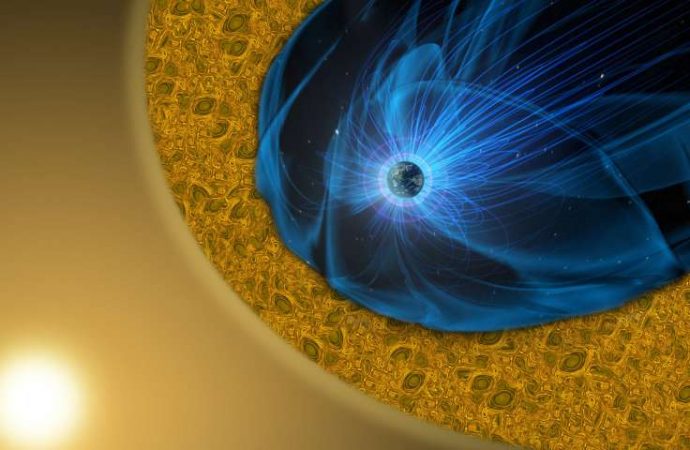When the solar wind – which is really a driving rain of charged particles from the sun – strikes Earth’s protective magnetic field, the shock generates roiling, turbulent magnetic fields that enshroud the planet and stretch for hundreds of thousands of miles.
Where does all that turbulent energy go?
One of NASA’s space weather missions, called Magnetospheric Multiscale or MMS, has discovered one surprising way this turbulent energy is dissipated: The magnetic energy is converted into high-speed jets of electrons as the magnetic fields break and reconnect.
The discovery will help scientists understand the role magnetic reconnection plays elsewhere in space, for example, in heating the inexplicably hot solar corona—the sun’s outer atmosphere—and accelerating the supersonic solar wind. NASA’s upcoming Parker Solar Probe mission will be launched directly toward the sun this summer to investigate exactly those phenomena, armed with this new understanding of magnetic reconnection near Earth.
And since magnetic reconnection occurs throughout the universe, what scientists learn about it around our planet—which is easier to examine—can be applied to other processes farther away.
“MMS discovered electron magnetic reconnection, a new process much different from the standard magnetic reconnection that happens in calmer areas around Earth,” said Tai Phan, a senior fellow in the Space Sciences Laboratory at the University of California, Berkeley. “This finding helps scientists understand how turbulent magnetic fields dissipate energy throughout the cosmos.”
Phan is lead author of a paper describing the findings that will be published this week in the journal Nature.
“Turbulence occurs everywhere in space: on the sun, in the solar wind, interstellar medium, dynamos, accretion disks around stars, in active galactic nuclei jets, supernova remnant shocks and more,” said Michael Shay of the University of Delaware, a co-author of the paper.
Turbulent magnetic fields are different
Standard magnetic reconnection is observed in Earth’s relatively placid magnetosphere, which is like a magnetic force field that protects the planet from the intense solar wind. Within this region, undulating magnetic fields can cross, break and reconnect; the rejoined magnetic field lines snap like a rubber band and fling ionized atoms at high velocity throughout the magnetosphere.
The ion jets, wedges of ionized hydrogen atoms speeding off in opposite directions, heat up the gases surrounding Earth and drive space weather. Some of the charged particles are funneled to the north and south poles, where they collide with atoms in the atmosphere and create the auroras.
The new process takes place farther from Earth’s surface, in a turbulent zone where the solar wind hits a shock wave surrounding Earth and drastically slows. Twice the width of the Earth itself, this zone – the magnetosheath – is highly turbulent.
“The turbulence in the magnetosheath contains a lot of magnetic energy,” Phan said. “People have been debating how this energy is dissipated, and magnetic reconnection is one of the possible processes.”
Phan and his colleagues used data from the MMS to prove that the new electron magnetic reconnection process happens on a smaller scale in turbulence and creates jets of electrons instead of ions. The electrons move about 40 times faster than ions accelerated by standard reconnection.
“We now have evidence that reconnection does happen to dissipate turbulent energy in the magnetosheath, but it is a new kind of reconnection,” said Shay.
Can magnetic fields be too turbulent to reconnect?
Magnetic reconnection has been observed innumerable times in the magnetosphere but always under calm conditions. The new event occurred in the magnetosheath just outside the outer boundary of the magnetosphere. Previously, scientists didn’t know if reconnection could occur there, because the plasma is highly chaotic in that region, Phan said.
MMS found that it does, but on scales much smaller than previous spacecraft could probe and theory would predict. Because it involves only electrons, it remained hidden from scientists looking for the telltale signature of standard magnetic reconnection: ion jets.
“We think this is because the electrons are fast and light and can easily participate, but the slow and heavy protons cannot,” said Jonathan Eastwood, a lecturer at Imperial College London and a co-author of the paper. “Overall, this result opens up new areas of research into turbulent reconnection.”
MMS consists of four identical spacecraft flying in a pyramid or tetrahedral formation to study magnetic reconnection around Earth in three-dimensions. Because the spacecraft fly incredibly close together—at an average separation of just four and a half miles—they are able to observe phenomena no one has seen before. Furthermore, MMS’s instruments are designed to capture data at speeds 100 times faster than previous missions.
Even though the instruments aboard MMS are incredibly fast, they are still too slow to capture turbulent reconnection in action, which requires observing narrow layers of fast-moving particles hurled by the recoiling field lines. Compared to standard reconnection, in which broad jets of ions stream out from the site of reconnection, turbulent reconnection ejects narrow jets of electrons only a couple miles wide.
But MMS scientists were able to leverage the design of one instrument, the Fast Plasma Investigation, to create a technique that allowed them to read between the lines and gather extra data points in order to resolve the jets.
“The key event of the paper happens in 45 milliseconds. This would be one data point with the regular data,” said Amy Rager, a graduate student at Catholic University of America in Washington, D.C., who worked at NASA’s Goddard Space Flight Center to develop the technique. “But instead we can get six to seven data points in that region with this method, allowing us to understand what is happening.”
With the new method, the MMS scientists are hopeful they can comb through existing datasets to find more of these events, and potentially other unexpected discoveries as well.
Source: Phys.org

































Leave a Comment
You must be logged in to post a comment.